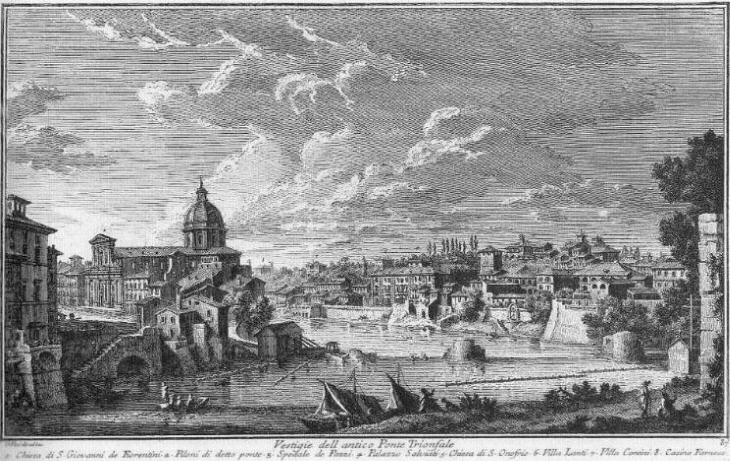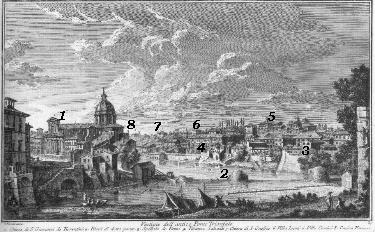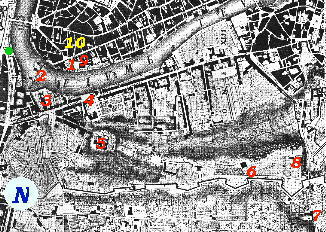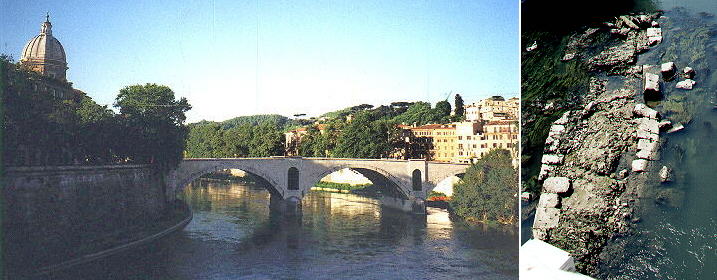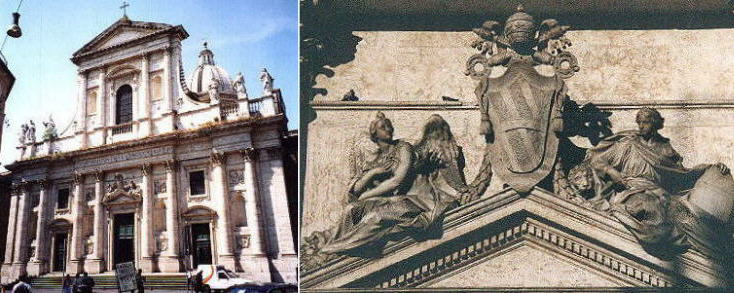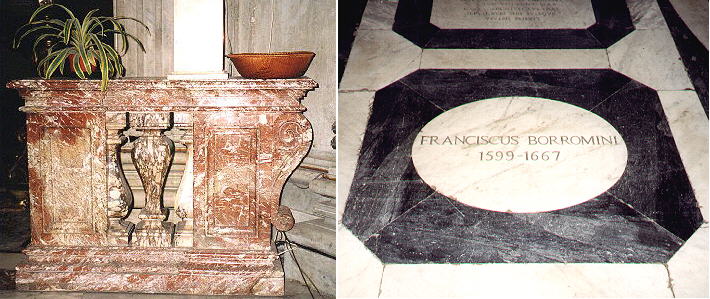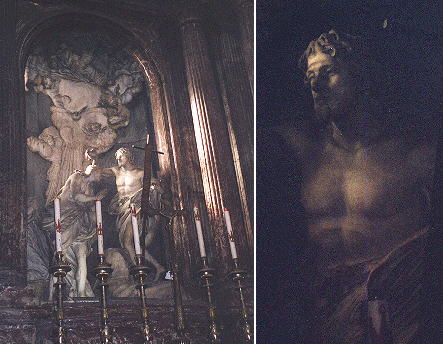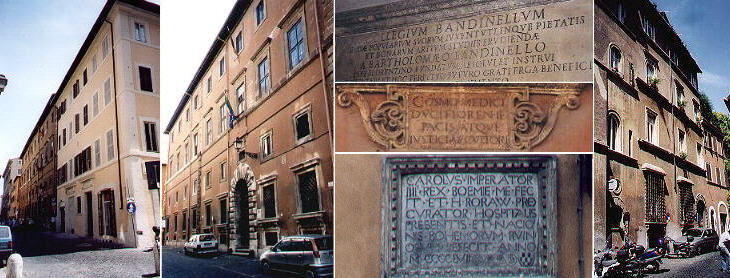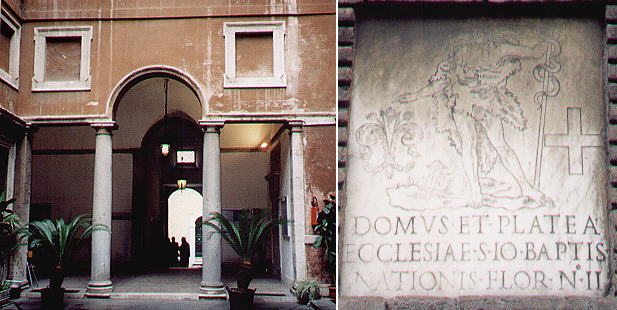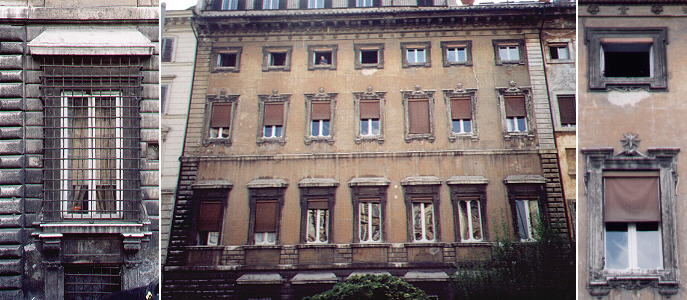

Vestigie del Antico
Ponte Trionfale (Book
5) (Map
C2) (Day 7) (View C4) (Rione Ponte)
In this page:
The plate by Giuseppe Vasi
Today's view
S. Giovanni dei Fiorentini
Borromini's end
Collegio Bandinelli e Consolato de' Fiorentini
Palazzo de Rossi
The Plate (No. 87)
There were eight bridges crossing the Tiber at the time of the Roman
Empire. Only three of them have survived (Ponte Milvio,
Ponte
degli Angeli and Ponte
Quattro Capi). This bridge was called Trionfale (Triumphalis) because
it was one of the preferred entrances of the consuls returning to Rome
to be recognised for their victories in a procession called triumph. The view shows in the background many landmarks of the Janiculus.
The view is taken from the green dot in the small 1748 map here below.
In the description below the plate Vasi made reference to: 1) S. Giovanni de' Fiorentini;
2) Pillars of Ponte Trionfale; 3) Spedale de' Pazzi; 4) Palazzo Salviati;
5) S. Onofrio;
6) Villa Lante; 7) Villa Corsini; 8) Casino Farnese. All but 1) and 2) are shown in detail in other pages.
The small map shows also 9) Collegio Bandinelli and 10) Palazzo De Rossi .
Today
A modern "rationalistic" bridge links today the banks of the Tiber.
In the background a nice view over the Janiculus (to the right S.
Onofrio). The high plane trees of the XIXth century Lungo Tevere hide most of the buildings shown in the plate.
In summer the ruins of the Roman bridge come to the surface.
S.
Giovanni dei
Fiorentini
The area shown in the plate on the left was the Little Florence of
Rome (in my background the symbol of Florence). Here the Florentine bankers
opened branches to finance the Papacy. The streets nearby still retain
memory of this past (Via Acciaioli, Via delle Palle, Via del Consolato).
The community needed a church and Leo X charged Jacopo Sansovino with
this undertaking, whilst Antonio da Sangallo was responsible for building
on the river the walls needed to support the church. The dome was built by Carlo Maderno in 1614. Like most of the churches
in Florence the fašade was left unfinished. Clemens XII, the last Pope
from Florence and a man of great wealth, completed the work of his predecessors
with this fašade by Alessandro Galilei (click here for a list of national churches in Rome). You may wish to
see the Monument to Alessandro Capponi by Michelangelo Slodtz inside the church. Many important sculptors of the XVIIth and XVIIIth
centuries worked at the funeral monuments of the rich Florentines buried in the church. The two statues (Charity and Strength) at the sides of the coat of arms were sculpted by Filippo Della Valle.
Borromini's
End
The Falconieri chapel (the main chapel) in S. Giovanni dei Fiorentini is the last work
by Francesco Borromini. The balustrade with inverted pillars which characterized
his first work in S.
Carlo alle Quattro Fontane shows up again as a sort of initials. He
killed himself in 1667 and he was buried in S. Giovanni dei Fiorentini, where his uncle Carlo Maderno was buried too. The chapel was initially designed
by Pietro da Cortona and after the changes made by Borromini it was completed by Ciro Ferri, a scholar of Pietro da Cortona. On the altar Antonio Raggi, the most
"Berninian" scholar of Bernini, made use for his Battesimo di Ges¨ of the technique devised by Bernini for many chapels and consisting in a
hidden window directing light towards some parts of the sculptures, with an effect common in paintings.
Collegio
Bandinelli
Via Giulia begins in the Florentine quarter of Rome. The first two buildings of the street
were of great importance for the Florentine community: Collegio Bandinelli was an institution
founded by the Florentine Bartolomeo Bandinelli (a baker) for the education of the
poor. It is now converted into flats but it retains some commemorative inscriptions.
The next building belonged to the Consulate
of Tuscany (the main building used as a Consulate was pulled down in 1888;
also the hospital of the community and the church of S. Orsola della PietÓ were sacrificed to the enlargement of the old Renaissance streets).
It was built by Antonio da Sangallo il Giovane and later on sold to the
Grand Duke of Tuscany Cosimo II (see a detail of its courtyard in the image below).
The adjacent streets retain several Renaissance houses built by the Florentine community.
In Rome the different Italian communities regarded themselves as different nations. In other countries however they tended to unite to form one
community (see how the Italian community in Prague was organized).
At the border of the Florentine quarter there was a very ancient hospice for the pilgrims of Bohemia: an inscription mentions as founder of the hospice
Charles IV, King of Bohemia (1346-78) and Emperor (1355-78), but the hospice already existed. It was renovated in 1457.
Palazzo
De Rossi
Palazzo De Rossi was built in the XVIIth century and it was spared by the redesigning of the streets near S. Giovanni dei Fiorentini.
However its ground floor with a very Florentine bugnato design is today at a level lower than that of the main street.
Excerpts from Giuseppe Vasi 1761 Itinerary related to this page:
Collegio Bandinelli
Poco dopo segue questo collegio eretto l'anno 1678. da Bartolommeo Bandinelli Fiorentino
per la giovent¨ della Toscana,che volesse apprendere le scienze umane e divine, ed
appresso evvi la
Chiesa di s. Gio: Battista de' Fiorentini
Nel fine della strada Giulia si alza questa magnifica chiesa eretta dalla nazione Fiorentina
in onore del s. Precursore suo patrono. Era quivi un orto con una cappella dedicata a
s. Pantaleo spettante al Capitolo di s. Celso, su cui nell'anno 1488. il Buonarroti
pensava di fare una chiesa a somiglianza della Rotonda; ma perchŔ era troppo grande
la spesa, quei nazionali appigliaronsi al disegno di Giacomo della Porta, che Ŕ a
guisa di basilica a tre navi con crociata e cupola. Sono in essa nobilissime cappelle
incrostate di marmi, e ornate con pitture, metalli, e stucchi dorati, fra le quali tiene
il primo luogo la maggiore fatta con disegno del Borromini, terminata per˛ per causa
di morte da Ciro Ferri, in cui si rappresenta il s. Titolare, che battezza il Salvatore,
espresso in marmo da Antonio Raggi, ed intorno altre sculture di Ercole Ferrata, e di
Domenico Guidi, e ne' laterali due depositi con altre sculture fatte da altri. Quelle
della crociata sono ancora riguardevoli per i due depositi, uno di Monsignor Corsini
fatto dall'Algardi, e l'altro di Monsig. Acciajoli di Ercole Ferrata, col quadro de
ss. Cosimo e Damiano dipinto da Salvatore Rosa; e nella cappella della ss. Vergine,
sonovi delle pitture del Fontebuoni, e del Ciampelli. Il santissimo Crocifisso
dall'altra parte, fu gettato in metallo dal modello di Prospero Bresciano, e le
pitture a fresco sulla volta sono del Lanfranco. Altre pitture e sculture si
vedono per le navi laterali, l'ultime delle quali sono state quelle del deposito del
March. Capponi fatte da Mons¨ Slos Francese, e l'altra quella del Pontefice Clemente XII.
per benemerenza di aver compito questo tempio con farli il prospetto secondo il disegno
di Alessandro Galilei. Accanto a questa Ŕ il convitto de' Preti, fra' quali visse Cesare
Baronio, che poi fu Cardinale, con altri seguaci di s. Filippo Neri, conservandosi ancora
alcune memorie di essi. Appresso vi Ŕ lo spedale eretto l'anno 1067. da Domenico Campi
Fiorentino per li suoi nazionali, e nel vicolo incontro l'
Oratorio della PietÓ, e Consolato de' Fiorentini
Il Pontefice Leone X. oltre aver dichiarato parrocchiale la suddetta chiesa, concedŔ alla
nazione Fiorentina il privileggio, che godessero di essa, ancorchŔ stassero in altre
parocchie, e di tenere un Ospizio col proprio Notaro per le cause de' mercanti a cui
presedono tre nobili col nome di Consolato. A destra di questo Ŕ l'oratorio, eretto
l'anno 1526. sopra un'antica chiesa dedicata a' ss. Tommaso ed Orsola, dalla
Confraternita de' Fiorentini, sotto il titolo della PietÓ, ed Ŕ tutto ornato di pitture
del Sermoneta, e delli Zucchari, il quadro per˛ sull'altare Ŕ di Girolamo Sicciolante.
Or prima di terminare questa giornata sarÓ bene di fare una osservazione presso il
Passo della Barchetta
A sinistra della suddetta chiesa di s. Giovanni corrisponde il terzo passaggio sopra
il Tevere per mezzo di un scafone, o vogliamo dire barchetta, per comodo degli abitatori
della strada detta la Lungara, come dicemmo nella passata giornata.
E' notabile, che da quella parte fu trovata nel Pontificato di Clemente XI. una vena di
acqua salubre, proveniente dal vicino monte Gianicolo; perci˛ vi fu eretto un fonte,
che dicesi, l'acqua Lancisiana, perchŔ dal Lancisi medico del Papa fu trovata, e
riconosciuta leggerissima. In mezzo a quel seno di fiume si vedono le
Rovine del Ponte Trionfale
Non solamente l'arco, la porta, il campo, e la via Trionfale ebbero gli antichi Romani,
ma altresý, il ponte di cui solamente ne vediamo il residuo de' piloni fra la riferita
chiesa di s. Giovanni de' Fiorentini, e lo spedale di s. Spirito. Egli fu detto trionfale,
perchŔ sopra di esso passavano con solennitÓ per decreto del Senato gli Eroi, che venivano
in Roma trionfanti de' nemici della Repubblica, e per˛ il campo, che Ŕ di lÓ dal ponte
dicevasi similmente trionfale, perchŔ ivi si metteva in ordinanza, e si principiava
l'accompagnamento de' Trionfanti.
|
Next plate in Book 5: Passo della Barchetta all'Armata
You have completed Day 7 itinerary! Move to Day 8.
Next step in your tour of Rione Ponte:
Palazzo Sacchetti a Via Giulia

Go
to  or to Book
5 or to my
Home
Page on Baroque Rome or to my Home Page on Rome
in the footsteps of an XVIIIth century traveller.
or to Book
5 or to my
Home
Page on Baroque Rome or to my Home Page on Rome
in the footsteps of an XVIIIth century traveller.
|


